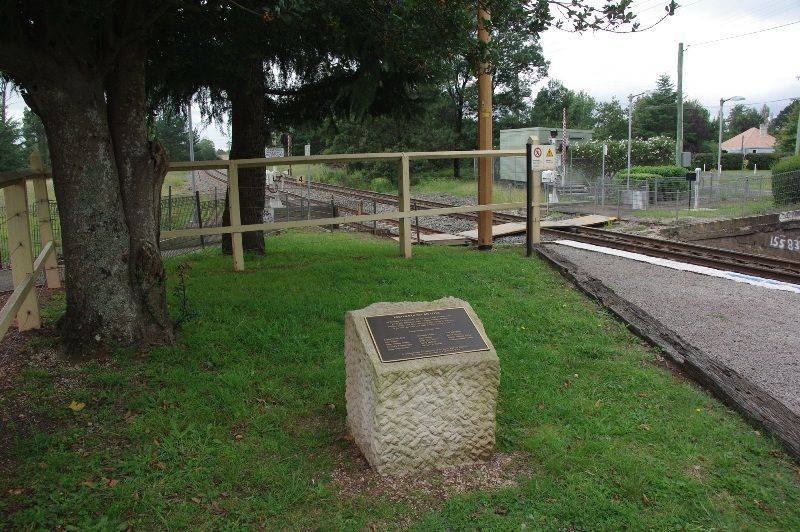
Home » Themes » Disaster » Land Transport
Exeter Railway DisasterPrint Page 
The plaque commemorates the centenary of the Exeter Rail Crash of 1914 which claimed 14 lives. The plaque is on a sandstone plinth on the northern end of the platform and in a spot that looks towards the point of impact in the crash. The plaque gives a brief description of what happened on the night and list the names of those killed
The Temora Mail train collided with a Sydney-bound goods train 200m north of Exeter. There were 134 passengers on board the mail train. At the time, it was the worst train crash in New South Wales' history.
At a subsequent trial, the driver of the Mail was brought before the Goulburn Circuit Court charged with manslaughter. After a retirement of more than four hours, a verdict of not guilty was delivered by the Jury.
The article below is from the Rainbow Argus, a small regional Victorian newspaper, and is largely based on the early reporting of the accident in the Sydney papers published the following morning, about six hours after the accident and with little factual information to build the story around. The (near) identical version was published in many regional newspapers.
Dashing through a fog at a fast speed, the Temora mail train crashed into a stationary goods train near the Exeter station, on the southern railway line, last night, with the resuit that 14 persons were killed and 26 others injured. This is the most disastrous railway accident that has ever occurred in the State. Exeter is a small station on the southern line, six miles from Moss Vale. Between it and Moss Vale is Werai. It is 93 miles from Sydney, and is in hilly country. Official reports received by the Railway Department in Sydney state that the collision was caused through the engine of the goods train coming out of a loop siding in order to permit of some trucks going through the points at the Wagga end of the loop into refuge. The goods train had arrived some minutes before the mail train was due, and it was intended to change the engines at Exeter. While the engine and several of the trucks were on the main line, and just inside the ''home signal", the Temora mail train dashed along the line and the collision occurred.
Following the crash, which was heard a great distance away, there were horrified cries, and the moaning of men and the screaming of women told of serious injury to passengers in the mail train. The forepart of this train and the engine and attached trucks of the goods' train were wrecked, and the wreckage lay piled up in a heap on the track.
Rainbow Argus (Vic), 21st March 1914.
Note : The actual information regarding the crash was that the Temora Mail did not exceed 20 miles per hour (mph) between Werai and Exeter. The down distant was off, so the driver approached Exeter expecting to run into the platform. Exeter was a conditional stop, and even if the train was not required to stop the tablets had to be exchanged and the mail bag put out. The crew of the mail van did not find the approach to Exeter to be problematic. The train had slowed after cresting the hill and was approaching the home signal at about 13mph.
The passing loop at Exeter was only about 500 feet and required most goods trains to run past the up starter under instructions from the signaller and go back onto the main line, while staying inside the down home. Once the end of the train had cleared the points to a refuge siding at the Goulburn end of the loop, the train could be backed into the siding to clear the main line.
The goods train arrived after the Temora Mail was due. Both trains were running late due to the heavy fog, but there was no intention to change the engines. The driver of the Temora Mail saw the goods train at a distance of about 65 yards and made an emergency brake application. The impact speed was about 7mph. The Temora Mail was not dashing along, and the crash made no more noise than a hard brake application would produce. The T Class on the goods suffered minor damage and was later used for shunting the accident site during the clean up.
The final death toll was 15. Geneve Fairbairn died some months later from her injuries, and the toll of 14 was correct at the time of publication.
The real question from the crash was why two passenger carriages could telescope so badly in a low speed collision. If this had been addressed the Murulla accident in 1926 may not have claimed 27 lives. This was lost in the railway's determination to place the blame for the accident on the train driver. The most likely cause was a signalling error.
(Additional Information supplied by Trevor Edmonds)
Location
| Address: | Bundanoon Road, Exeter Railway Station, Exeter, 2579 |
|---|---|
| State: | NSW |
| Area: | AUS |
| GPS Coordinates: | Lat: -34.613451 Long: 150.317539 Note: GPS Coordinates are approximate. |
Details
| Monument Type: | Plaque |
|---|---|
| Monument Theme: | Disaster |
| Sub-Theme: | Land Transport |
| Actual Event Start Date: | 13th-March-1914 |
| Actual Event End Date: | 13th-March-2014 |
Dedication
| Actual Monument Dedication Date: | Friday 13th March, 2015 |
|---|
EXETER RAILWAY DISASTER
On the night of 13th March 1914 the Temora mail collided with a
goods train 200 metres north of Exeter Railway Station.
Fourteen people were killed and twenty-four injured in what was,
at the time, the worst train crash in NSW railway history.
Remembering those who died :
(Names)
To commemorate the centenary of the Exeter Railway Disaster
this plaque was unveiled on 13th March 2014






